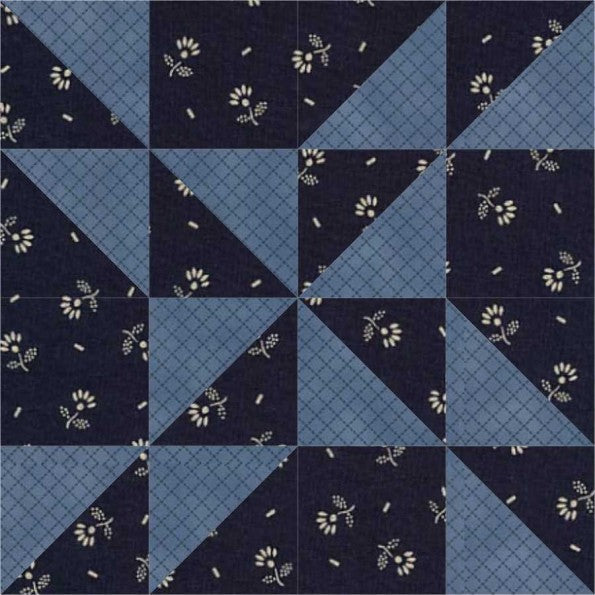
Year's Favourite Quilt Block Pattern

To keep these classes free please leave a donation for the teacher here. https://customclothingboutique.com/products/donat-to-motley-muse

Click here for a beginner in depth sewing class on all the basics. https://customclothingboutique.com/pages/quilting-knowledge
This is a great technique for making half square triangles that eliminates the need to directly manipulate the stretchy bias of the triangle. It utilizes two easy to cut squares producing two half square triangles.
On the back of the lighter fabric, draw a pencil line, diagonally from corner to corner.

Stack a pair of light and dark squares, right sides together. Sew a 1/4 inch seam allowance on each side of the line.

You will end up with something like this.

Now cut along the diagonal line.

Press the seam together to set the seam. Then press towards the darkest fabric.

To trim the block to the exact size line up the diagonal 45°angle with the ruler on your seam.

And then carefully trim your block with a rotary cutter.

The secret to the perfect four patch is all about ironing seams so that they butt together when the seams are joined. You may make the four patch by cutting individual squares if you want to make a scrappy quilt or only a few blocks to make with pre-joined strips. I'll take you through both methods.

Cut two A squares and two B squares in your required size. Chain piecing, join A square to a B square, right sides together, with a scant 1/4 inch seam allowance. Press towards the dark fabric.
This is your result:

This is also the result of cutting across pre-joined strips to create two units.
To make a standard four patch, the width of the unit cut from pre-joined strips is the same as the width of the original strips.
Press all the seams towards the dark fabric so that the seame butt-up.
Take the two A/B and place them right sides together, butting seams. Pin if required. Join with a scant 1/4 inch seam allowance, then press.

Wider Application:
You can apply this technique to all kinds of four patch blocks. As long as a block has a 4x4 grid, no matter how many pieces, the basic principles apply. It is repeated over and over again each four patch laying adjacent to the next. As long as you keep pressing seams in pairs of opposite directions, piecing will become easy.
All of the following blocks have 4x4 grids and can be pieaced as a four patch.

How to Resize Quilt Blocks:
The first step in modifying any quilt block is to decide on the size of your finished quilt block. You can come to a decision based on a number of factors: doubling a pattern, cutting your pattern in half, or choosing the size based on your available fabric.
NOTE: When working from a pattern’s cutting instructions, make sure you remove the seam allowance before doubling or tripling the size. For instance, if your pattern calls for 3-1/2″ squares, first you’ll subtract the sum of the seam allowances (1/2″), double the finished block size (from 3″ to 6″), and add the seam allowance back in (1/2″). So, when all is said and done, you will cut a 6-1/2″ piece of fabric.
Resizing Square Blocks:
Square blocks are the easiest to resize. Simply add to your finished block measurement. For example, if you’d like your finished block to be a 4″ square, you’ll need to cut a 4-1/2″ square of fabric.
Resizing Rectangular Blocks:
Similarly to the square, for rectangle blocks, you’ll add to the length and width measurements of your finished block. If you’re doubling block that measures 3″ x 4″ in your quilt, you’ll cut a 6-1/2″ x 8-1/2″ rectangle of fabric.
Resizing Half-Square Triangle Blocks:
When you want to change the size of a Half-Square Triangle block, add 7/8″ to the desired finished block size. To make a 4″ finished block, you’d cut 4-7/8″ squares.
Resizing Quarter Square Triangle:
Since there are two cut lines and two seam lines in a Quarter-Square Triangle block you’ll need to add 1-1/4″ to the desired finished block size. For a finished block that’s 4″, you’d cut your squares 5-1/4″.
